Disruptive Innovation: Impact of E-Hailing on Taxi Drivers in KL
VerifiedAdded on 2023/06/15
|28
|9048
|160
Literature Review
AI Summary
This literature review explores the disruptive innovation of e-hailing ride services and their impact on taxi drivers in Kuala Lumpur, focusing on financial, health, mental wellbeing, and social aspects. It discusses the rise of e-hailing services like Uber and Grab, their legalization in Malaysia, and their effects on traffic congestion and urban commuting. The review contrasts traditional taxi services with app-based alternatives, highlighting the competition, benefits for customers and drivers, and the overall transformation of the personal transportation industry. It also addresses the different types of innovation, including incremental, architectural, radical, and disruptive, and how e-hailing has led to new policies and adaptations within the taxi industry to maintain market share. Desklib provides access to this full document along with a variety of study resources.
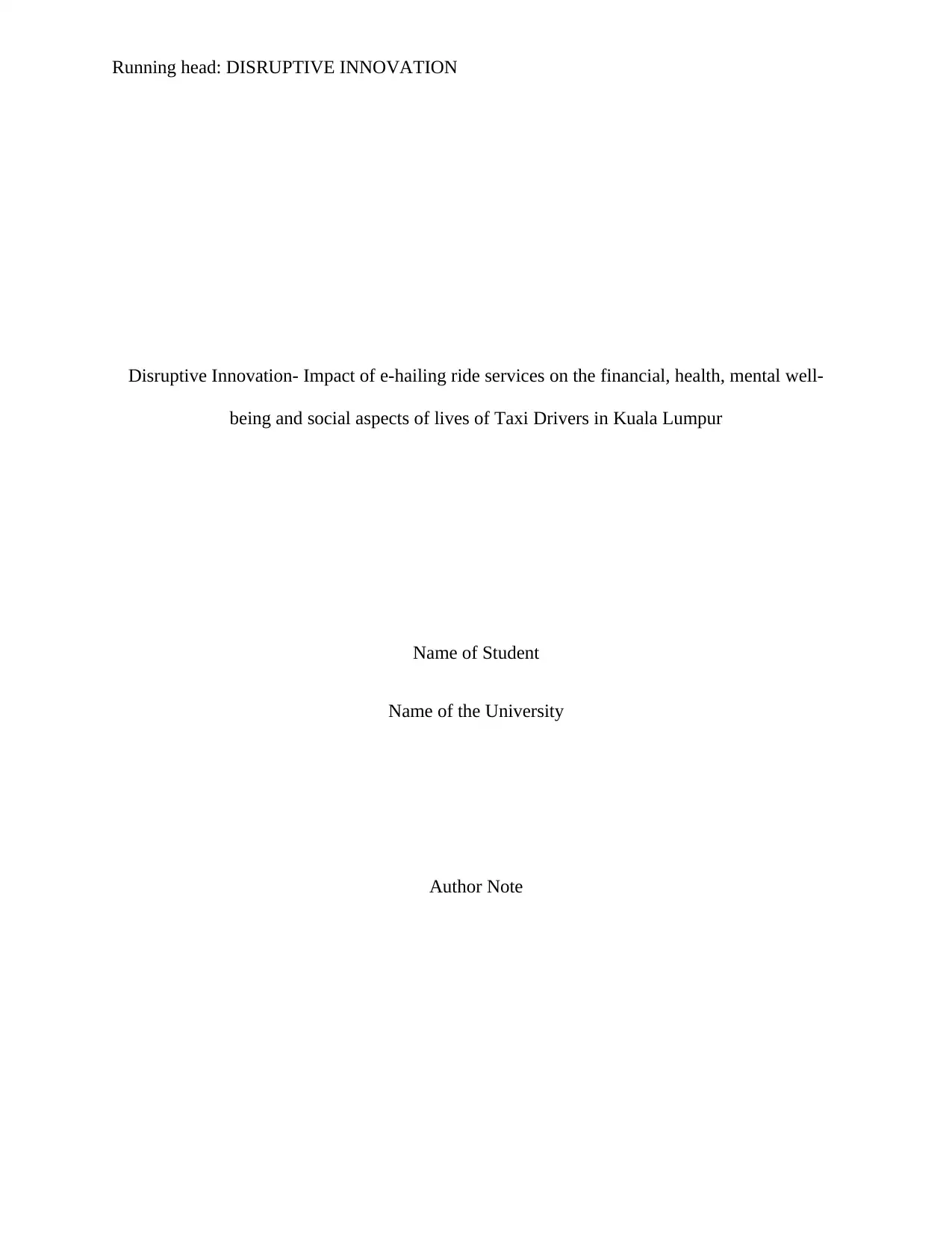
Running head: DISRUPTIVE INNOVATION
Disruptive Innovation- Impact of e-hailing ride services on the financial, health, mental well-
being and social aspects of lives of Taxi Drivers in Kuala Lumpur
Name of Student
Name of the University
Author Note
Disruptive Innovation- Impact of e-hailing ride services on the financial, health, mental well-
being and social aspects of lives of Taxi Drivers in Kuala Lumpur
Name of Student
Name of the University
Author Note
Paraphrase This Document
Need a fresh take? Get an instant paraphrase of this document with our AI Paraphraser
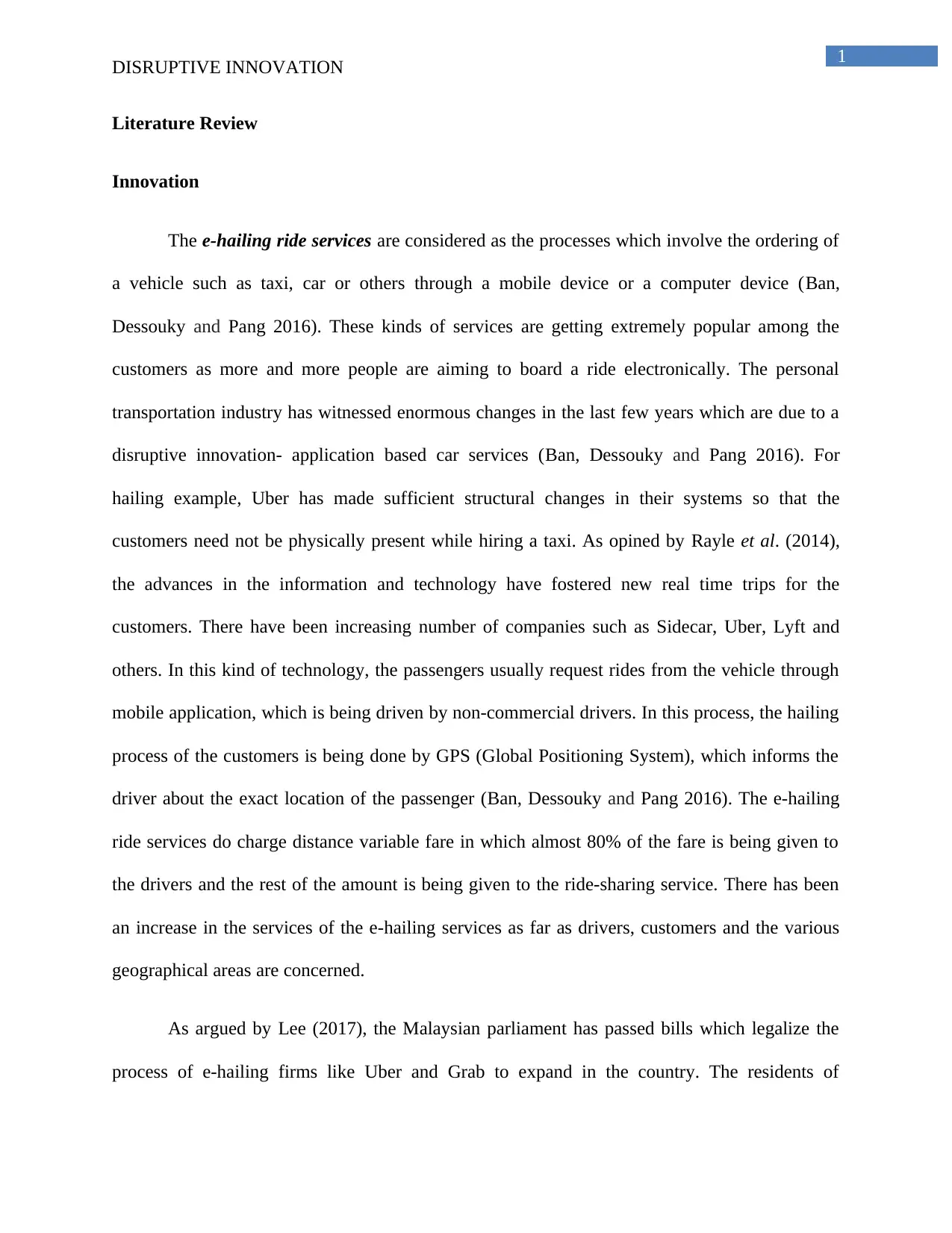
1
DISRUPTIVE INNOVATION
Literature Review
Innovation
The e-hailing ride services are considered as the processes which involve the ordering of
a vehicle such as taxi, car or others through a mobile device or a computer device (Ban,
Dessouky and Pang 2016). These kinds of services are getting extremely popular among the
customers as more and more people are aiming to board a ride electronically. The personal
transportation industry has witnessed enormous changes in the last few years which are due to a
disruptive innovation- application based car services (Ban, Dessouky and Pang 2016). For
hailing example, Uber has made sufficient structural changes in their systems so that the
customers need not be physically present while hiring a taxi. As opined by Rayle et al. (2014),
the advances in the information and technology have fostered new real time trips for the
customers. There have been increasing number of companies such as Sidecar, Uber, Lyft and
others. In this kind of technology, the passengers usually request rides from the vehicle through
mobile application, which is being driven by non-commercial drivers. In this process, the hailing
process of the customers is being done by GPS (Global Positioning System), which informs the
driver about the exact location of the passenger (Ban, Dessouky and Pang 2016). The e-hailing
ride services do charge distance variable fare in which almost 80% of the fare is being given to
the drivers and the rest of the amount is being given to the ride-sharing service. There has been
an increase in the services of the e-hailing services as far as drivers, customers and the various
geographical areas are concerned.
As argued by Lee (2017), the Malaysian parliament has passed bills which legalize the
process of e-hailing firms like Uber and Grab to expand in the country. The residents of
DISRUPTIVE INNOVATION
Literature Review
Innovation
The e-hailing ride services are considered as the processes which involve the ordering of
a vehicle such as taxi, car or others through a mobile device or a computer device (Ban,
Dessouky and Pang 2016). These kinds of services are getting extremely popular among the
customers as more and more people are aiming to board a ride electronically. The personal
transportation industry has witnessed enormous changes in the last few years which are due to a
disruptive innovation- application based car services (Ban, Dessouky and Pang 2016). For
hailing example, Uber has made sufficient structural changes in their systems so that the
customers need not be physically present while hiring a taxi. As opined by Rayle et al. (2014),
the advances in the information and technology have fostered new real time trips for the
customers. There have been increasing number of companies such as Sidecar, Uber, Lyft and
others. In this kind of technology, the passengers usually request rides from the vehicle through
mobile application, which is being driven by non-commercial drivers. In this process, the hailing
process of the customers is being done by GPS (Global Positioning System), which informs the
driver about the exact location of the passenger (Ban, Dessouky and Pang 2016). The e-hailing
ride services do charge distance variable fare in which almost 80% of the fare is being given to
the drivers and the rest of the amount is being given to the ride-sharing service. There has been
an increase in the services of the e-hailing services as far as drivers, customers and the various
geographical areas are concerned.
As argued by Lee (2017), the Malaysian parliament has passed bills which legalize the
process of e-hailing firms like Uber and Grab to expand in the country. The residents of
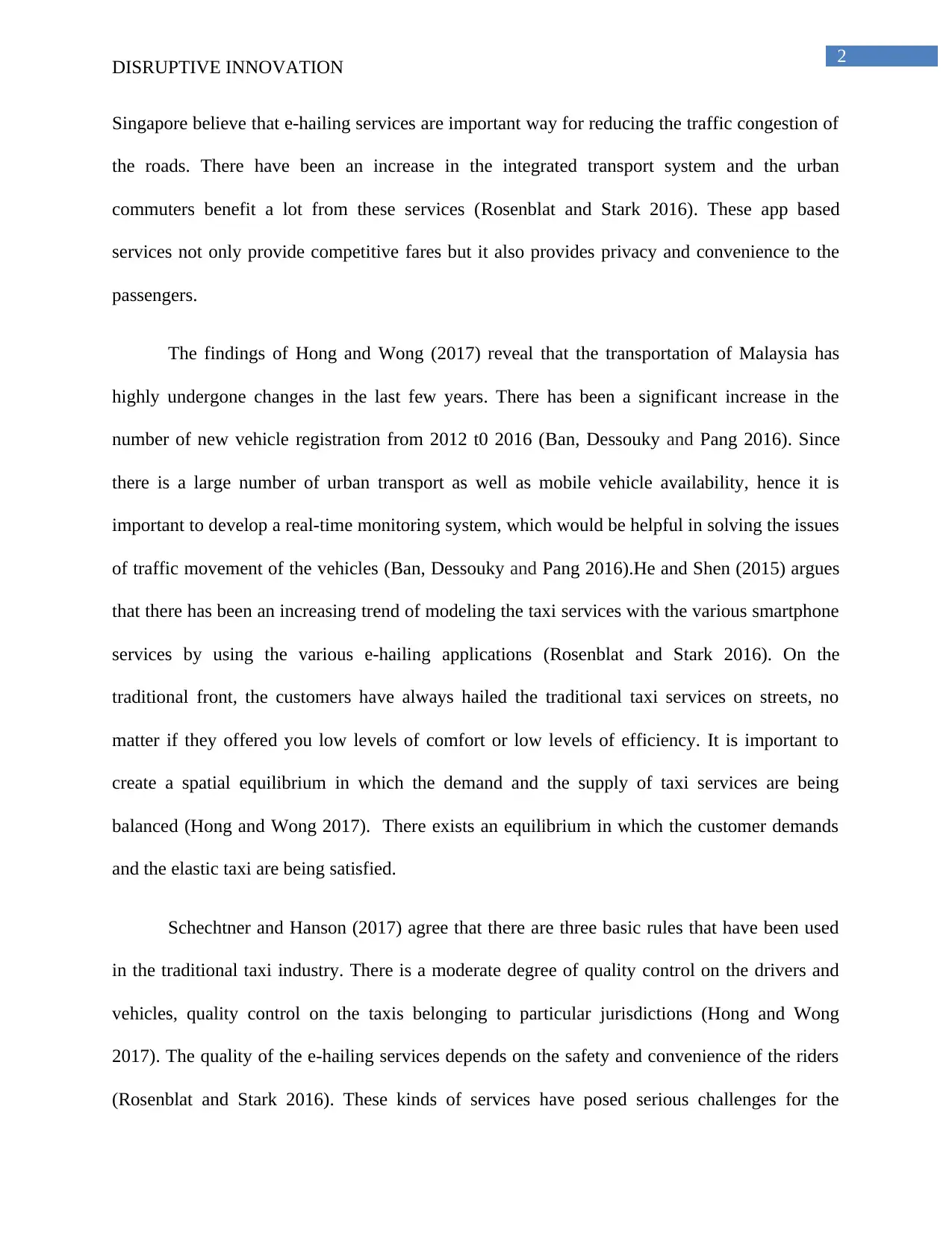
2
DISRUPTIVE INNOVATION
Singapore believe that e-hailing services are important way for reducing the traffic congestion of
the roads. There have been an increase in the integrated transport system and the urban
commuters benefit a lot from these services (Rosenblat and Stark 2016). These app based
services not only provide competitive fares but it also provides privacy and convenience to the
passengers.
The findings of Hong and Wong (2017) reveal that the transportation of Malaysia has
highly undergone changes in the last few years. There has been a significant increase in the
number of new vehicle registration from 2012 t0 2016 (Ban, Dessouky and Pang 2016). Since
there is a large number of urban transport as well as mobile vehicle availability, hence it is
important to develop a real-time monitoring system, which would be helpful in solving the issues
of traffic movement of the vehicles (Ban, Dessouky and Pang 2016).He and Shen (2015) argues
that there has been an increasing trend of modeling the taxi services with the various smartphone
services by using the various e-hailing applications (Rosenblat and Stark 2016). On the
traditional front, the customers have always hailed the traditional taxi services on streets, no
matter if they offered you low levels of comfort or low levels of efficiency. It is important to
create a spatial equilibrium in which the demand and the supply of taxi services are being
balanced (Hong and Wong 2017). There exists an equilibrium in which the customer demands
and the elastic taxi are being satisfied.
Schechtner and Hanson (2017) agree that there are three basic rules that have been used
in the traditional taxi industry. There is a moderate degree of quality control on the drivers and
vehicles, quality control on the taxis belonging to particular jurisdictions (Hong and Wong
2017). The quality of the e-hailing services depends on the safety and convenience of the riders
(Rosenblat and Stark 2016). These kinds of services have posed serious challenges for the
DISRUPTIVE INNOVATION
Singapore believe that e-hailing services are important way for reducing the traffic congestion of
the roads. There have been an increase in the integrated transport system and the urban
commuters benefit a lot from these services (Rosenblat and Stark 2016). These app based
services not only provide competitive fares but it also provides privacy and convenience to the
passengers.
The findings of Hong and Wong (2017) reveal that the transportation of Malaysia has
highly undergone changes in the last few years. There has been a significant increase in the
number of new vehicle registration from 2012 t0 2016 (Ban, Dessouky and Pang 2016). Since
there is a large number of urban transport as well as mobile vehicle availability, hence it is
important to develop a real-time monitoring system, which would be helpful in solving the issues
of traffic movement of the vehicles (Ban, Dessouky and Pang 2016).He and Shen (2015) argues
that there has been an increasing trend of modeling the taxi services with the various smartphone
services by using the various e-hailing applications (Rosenblat and Stark 2016). On the
traditional front, the customers have always hailed the traditional taxi services on streets, no
matter if they offered you low levels of comfort or low levels of efficiency. It is important to
create a spatial equilibrium in which the demand and the supply of taxi services are being
balanced (Hong and Wong 2017). There exists an equilibrium in which the customer demands
and the elastic taxi are being satisfied.
Schechtner and Hanson (2017) agree that there are three basic rules that have been used
in the traditional taxi industry. There is a moderate degree of quality control on the drivers and
vehicles, quality control on the taxis belonging to particular jurisdictions (Hong and Wong
2017). The quality of the e-hailing services depends on the safety and convenience of the riders
(Rosenblat and Stark 2016). These kinds of services have posed serious challenges for the
⊘ This is a preview!⊘
Do you want full access?
Subscribe today to unlock all pages.

Trusted by 1+ million students worldwide
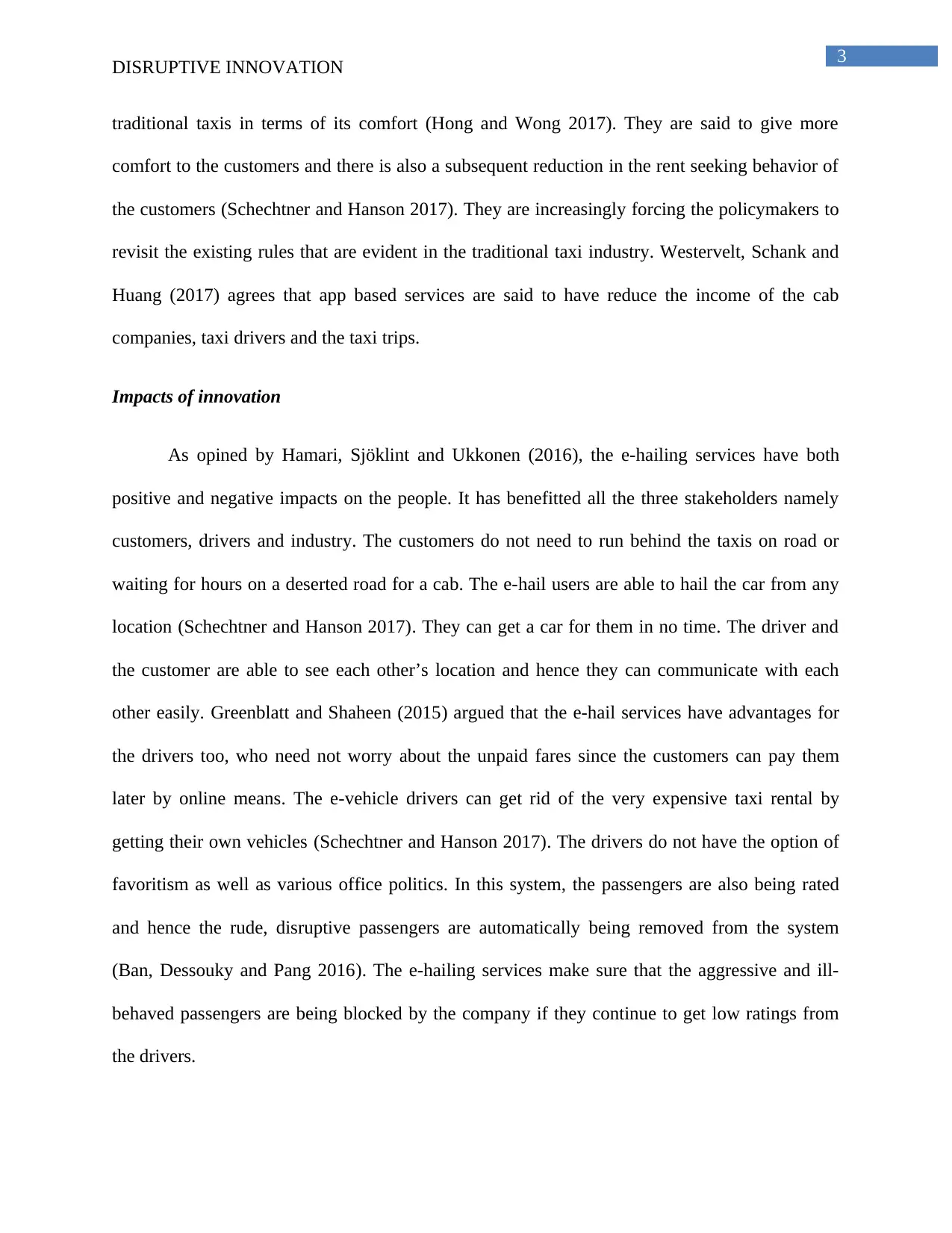
3
DISRUPTIVE INNOVATION
traditional taxis in terms of its comfort (Hong and Wong 2017). They are said to give more
comfort to the customers and there is also a subsequent reduction in the rent seeking behavior of
the customers (Schechtner and Hanson 2017). They are increasingly forcing the policymakers to
revisit the existing rules that are evident in the traditional taxi industry. Westervelt, Schank and
Huang (2017) agrees that app based services are said to have reduce the income of the cab
companies, taxi drivers and the taxi trips.
Impacts of innovation
As opined by Hamari, Sjöklint and Ukkonen (2016), the e-hailing services have both
positive and negative impacts on the people. It has benefitted all the three stakeholders namely
customers, drivers and industry. The customers do not need to run behind the taxis on road or
waiting for hours on a deserted road for a cab. The e-hail users are able to hail the car from any
location (Schechtner and Hanson 2017). They can get a car for them in no time. The driver and
the customer are able to see each other’s location and hence they can communicate with each
other easily. Greenblatt and Shaheen (2015) argued that the e-hail services have advantages for
the drivers too, who need not worry about the unpaid fares since the customers can pay them
later by online means. The e-vehicle drivers can get rid of the very expensive taxi rental by
getting their own vehicles (Schechtner and Hanson 2017). The drivers do not have the option of
favoritism as well as various office politics. In this system, the passengers are also being rated
and hence the rude, disruptive passengers are automatically being removed from the system
(Ban, Dessouky and Pang 2016). The e-hailing services make sure that the aggressive and ill-
behaved passengers are being blocked by the company if they continue to get low ratings from
the drivers.
DISRUPTIVE INNOVATION
traditional taxis in terms of its comfort (Hong and Wong 2017). They are said to give more
comfort to the customers and there is also a subsequent reduction in the rent seeking behavior of
the customers (Schechtner and Hanson 2017). They are increasingly forcing the policymakers to
revisit the existing rules that are evident in the traditional taxi industry. Westervelt, Schank and
Huang (2017) agrees that app based services are said to have reduce the income of the cab
companies, taxi drivers and the taxi trips.
Impacts of innovation
As opined by Hamari, Sjöklint and Ukkonen (2016), the e-hailing services have both
positive and negative impacts on the people. It has benefitted all the three stakeholders namely
customers, drivers and industry. The customers do not need to run behind the taxis on road or
waiting for hours on a deserted road for a cab. The e-hail users are able to hail the car from any
location (Schechtner and Hanson 2017). They can get a car for them in no time. The driver and
the customer are able to see each other’s location and hence they can communicate with each
other easily. Greenblatt and Shaheen (2015) argued that the e-hail services have advantages for
the drivers too, who need not worry about the unpaid fares since the customers can pay them
later by online means. The e-vehicle drivers can get rid of the very expensive taxi rental by
getting their own vehicles (Schechtner and Hanson 2017). The drivers do not have the option of
favoritism as well as various office politics. In this system, the passengers are also being rated
and hence the rude, disruptive passengers are automatically being removed from the system
(Ban, Dessouky and Pang 2016). The e-hailing services make sure that the aggressive and ill-
behaved passengers are being blocked by the company if they continue to get low ratings from
the drivers.
Paraphrase This Document
Need a fresh take? Get an instant paraphrase of this document with our AI Paraphraser
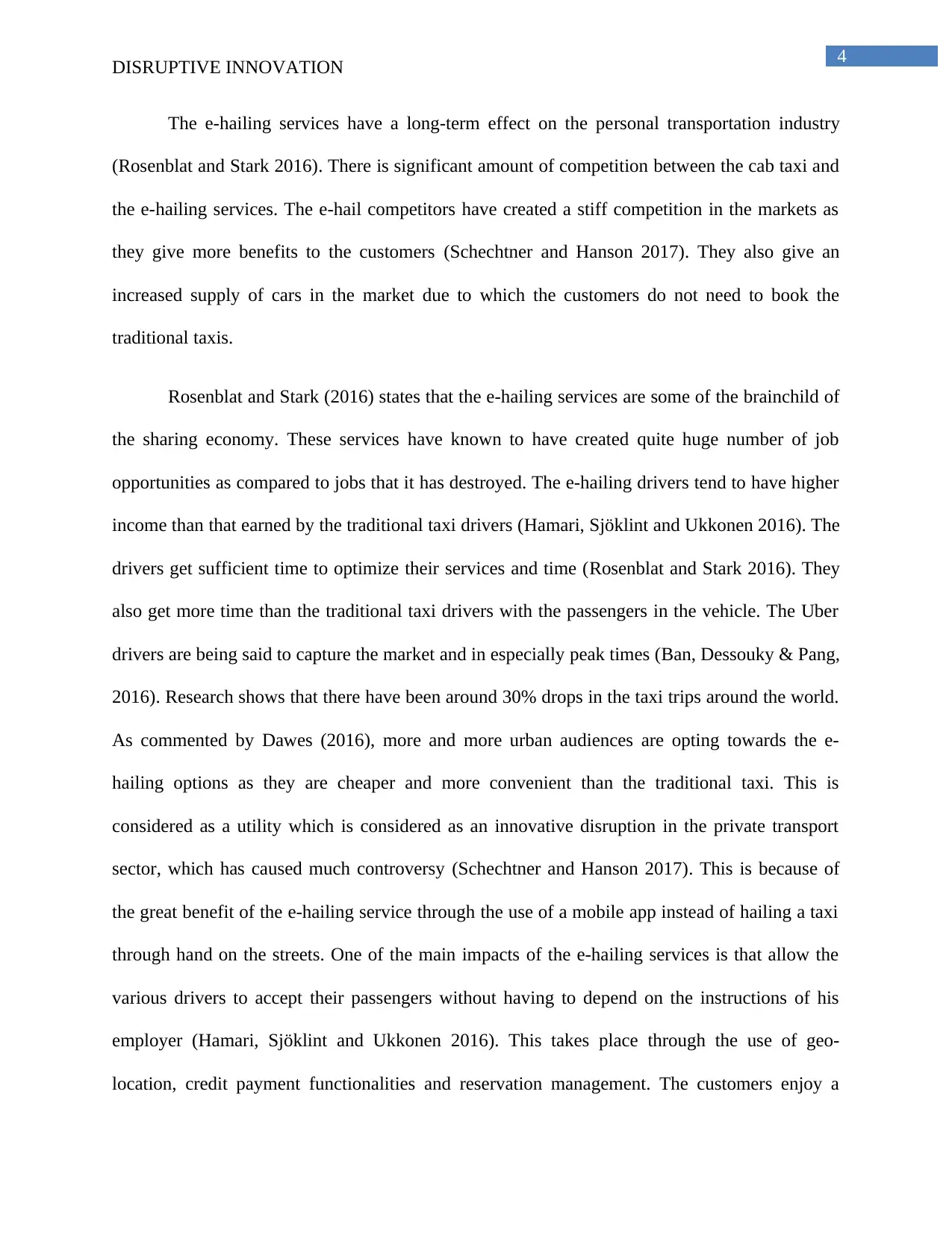
4
DISRUPTIVE INNOVATION
The e-hailing services have a long-term effect on the personal transportation industry
(Rosenblat and Stark 2016). There is significant amount of competition between the cab taxi and
the e-hailing services. The e-hail competitors have created a stiff competition in the markets as
they give more benefits to the customers (Schechtner and Hanson 2017). They also give an
increased supply of cars in the market due to which the customers do not need to book the
traditional taxis.
Rosenblat and Stark (2016) states that the e-hailing services are some of the brainchild of
the sharing economy. These services have known to have created quite huge number of job
opportunities as compared to jobs that it has destroyed. The e-hailing drivers tend to have higher
income than that earned by the traditional taxi drivers (Hamari, Sjöklint and Ukkonen 2016). The
drivers get sufficient time to optimize their services and time (Rosenblat and Stark 2016). They
also get more time than the traditional taxi drivers with the passengers in the vehicle. The Uber
drivers are being said to capture the market and in especially peak times (Ban, Dessouky & Pang,
2016). Research shows that there have been around 30% drops in the taxi trips around the world.
As commented by Dawes (2016), more and more urban audiences are opting towards the e-
hailing options as they are cheaper and more convenient than the traditional taxi. This is
considered as a utility which is considered as an innovative disruption in the private transport
sector, which has caused much controversy (Schechtner and Hanson 2017). This is because of
the great benefit of the e-hailing service through the use of a mobile app instead of hailing a taxi
through hand on the streets. One of the main impacts of the e-hailing services is that allow the
various drivers to accept their passengers without having to depend on the instructions of his
employer (Hamari, Sjöklint and Ukkonen 2016). This takes place through the use of geo-
location, credit payment functionalities and reservation management. The customers enjoy a
DISRUPTIVE INNOVATION
The e-hailing services have a long-term effect on the personal transportation industry
(Rosenblat and Stark 2016). There is significant amount of competition between the cab taxi and
the e-hailing services. The e-hail competitors have created a stiff competition in the markets as
they give more benefits to the customers (Schechtner and Hanson 2017). They also give an
increased supply of cars in the market due to which the customers do not need to book the
traditional taxis.
Rosenblat and Stark (2016) states that the e-hailing services are some of the brainchild of
the sharing economy. These services have known to have created quite huge number of job
opportunities as compared to jobs that it has destroyed. The e-hailing drivers tend to have higher
income than that earned by the traditional taxi drivers (Hamari, Sjöklint and Ukkonen 2016). The
drivers get sufficient time to optimize their services and time (Rosenblat and Stark 2016). They
also get more time than the traditional taxi drivers with the passengers in the vehicle. The Uber
drivers are being said to capture the market and in especially peak times (Ban, Dessouky & Pang,
2016). Research shows that there have been around 30% drops in the taxi trips around the world.
As commented by Dawes (2016), more and more urban audiences are opting towards the e-
hailing options as they are cheaper and more convenient than the traditional taxi. This is
considered as a utility which is considered as an innovative disruption in the private transport
sector, which has caused much controversy (Schechtner and Hanson 2017). This is because of
the great benefit of the e-hailing service through the use of a mobile app instead of hailing a taxi
through hand on the streets. One of the main impacts of the e-hailing services is that allow the
various drivers to accept their passengers without having to depend on the instructions of his
employer (Hamari, Sjöklint and Ukkonen 2016). This takes place through the use of geo-
location, credit payment functionalities and reservation management. The customers enjoy a
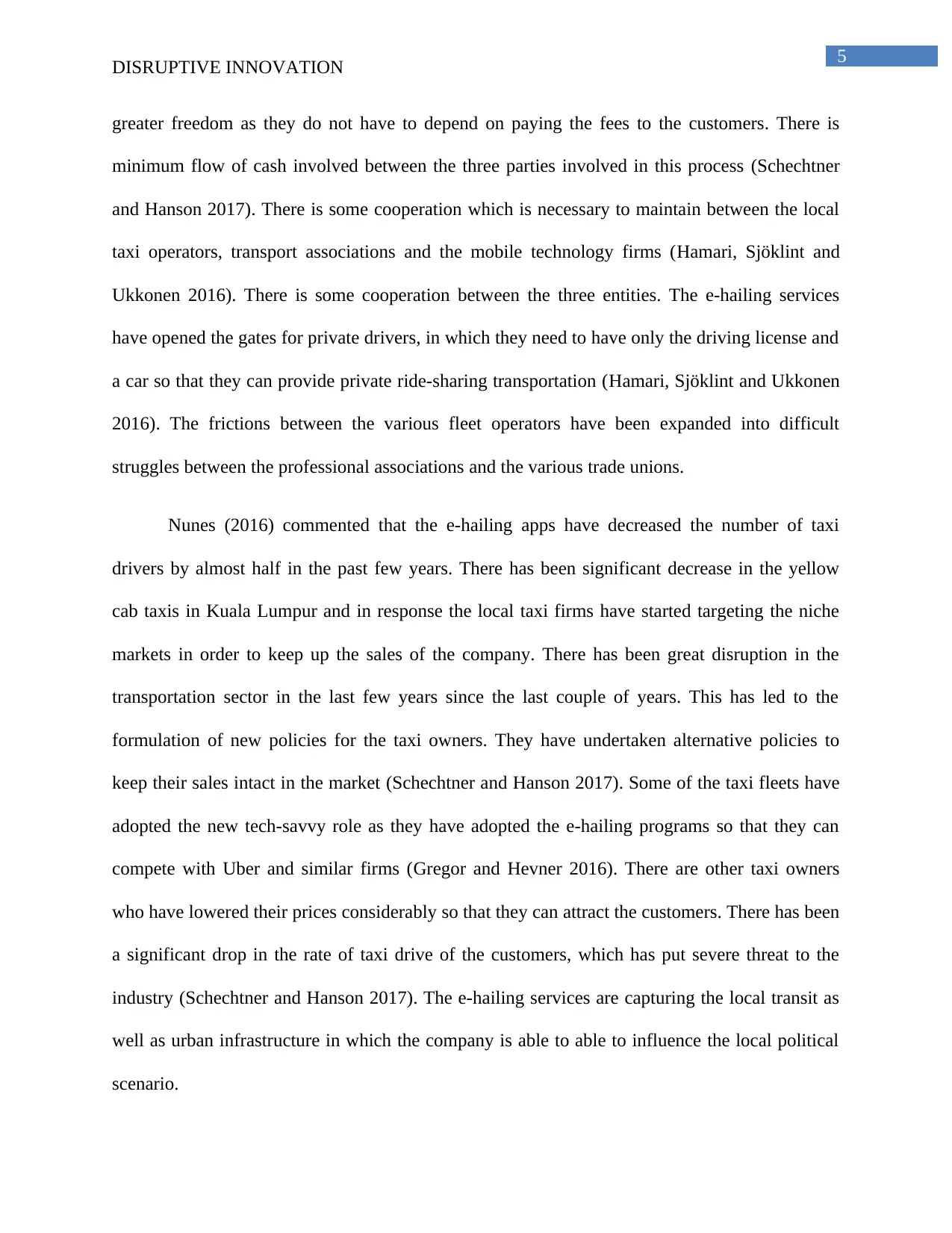
5
DISRUPTIVE INNOVATION
greater freedom as they do not have to depend on paying the fees to the customers. There is
minimum flow of cash involved between the three parties involved in this process (Schechtner
and Hanson 2017). There is some cooperation which is necessary to maintain between the local
taxi operators, transport associations and the mobile technology firms (Hamari, Sjöklint and
Ukkonen 2016). There is some cooperation between the three entities. The e-hailing services
have opened the gates for private drivers, in which they need to have only the driving license and
a car so that they can provide private ride-sharing transportation (Hamari, Sjöklint and Ukkonen
2016). The frictions between the various fleet operators have been expanded into difficult
struggles between the professional associations and the various trade unions.
Nunes (2016) commented that the e-hailing apps have decreased the number of taxi
drivers by almost half in the past few years. There has been significant decrease in the yellow
cab taxis in Kuala Lumpur and in response the local taxi firms have started targeting the niche
markets in order to keep up the sales of the company. There has been great disruption in the
transportation sector in the last few years since the last couple of years. This has led to the
formulation of new policies for the taxi owners. They have undertaken alternative policies to
keep their sales intact in the market (Schechtner and Hanson 2017). Some of the taxi fleets have
adopted the new tech-savvy role as they have adopted the e-hailing programs so that they can
compete with Uber and similar firms (Gregor and Hevner 2016). There are other taxi owners
who have lowered their prices considerably so that they can attract the customers. There has been
a significant drop in the rate of taxi drive of the customers, which has put severe threat to the
industry (Schechtner and Hanson 2017). The e-hailing services are capturing the local transit as
well as urban infrastructure in which the company is able to able to influence the local political
scenario.
DISRUPTIVE INNOVATION
greater freedom as they do not have to depend on paying the fees to the customers. There is
minimum flow of cash involved between the three parties involved in this process (Schechtner
and Hanson 2017). There is some cooperation which is necessary to maintain between the local
taxi operators, transport associations and the mobile technology firms (Hamari, Sjöklint and
Ukkonen 2016). There is some cooperation between the three entities. The e-hailing services
have opened the gates for private drivers, in which they need to have only the driving license and
a car so that they can provide private ride-sharing transportation (Hamari, Sjöklint and Ukkonen
2016). The frictions between the various fleet operators have been expanded into difficult
struggles between the professional associations and the various trade unions.
Nunes (2016) commented that the e-hailing apps have decreased the number of taxi
drivers by almost half in the past few years. There has been significant decrease in the yellow
cab taxis in Kuala Lumpur and in response the local taxi firms have started targeting the niche
markets in order to keep up the sales of the company. There has been great disruption in the
transportation sector in the last few years since the last couple of years. This has led to the
formulation of new policies for the taxi owners. They have undertaken alternative policies to
keep their sales intact in the market (Schechtner and Hanson 2017). Some of the taxi fleets have
adopted the new tech-savvy role as they have adopted the e-hailing programs so that they can
compete with Uber and similar firms (Gregor and Hevner 2016). There are other taxi owners
who have lowered their prices considerably so that they can attract the customers. There has been
a significant drop in the rate of taxi drive of the customers, which has put severe threat to the
industry (Schechtner and Hanson 2017). The e-hailing services are capturing the local transit as
well as urban infrastructure in which the company is able to able to influence the local political
scenario.
⊘ This is a preview!⊘
Do you want full access?
Subscribe today to unlock all pages.

Trusted by 1+ million students worldwide
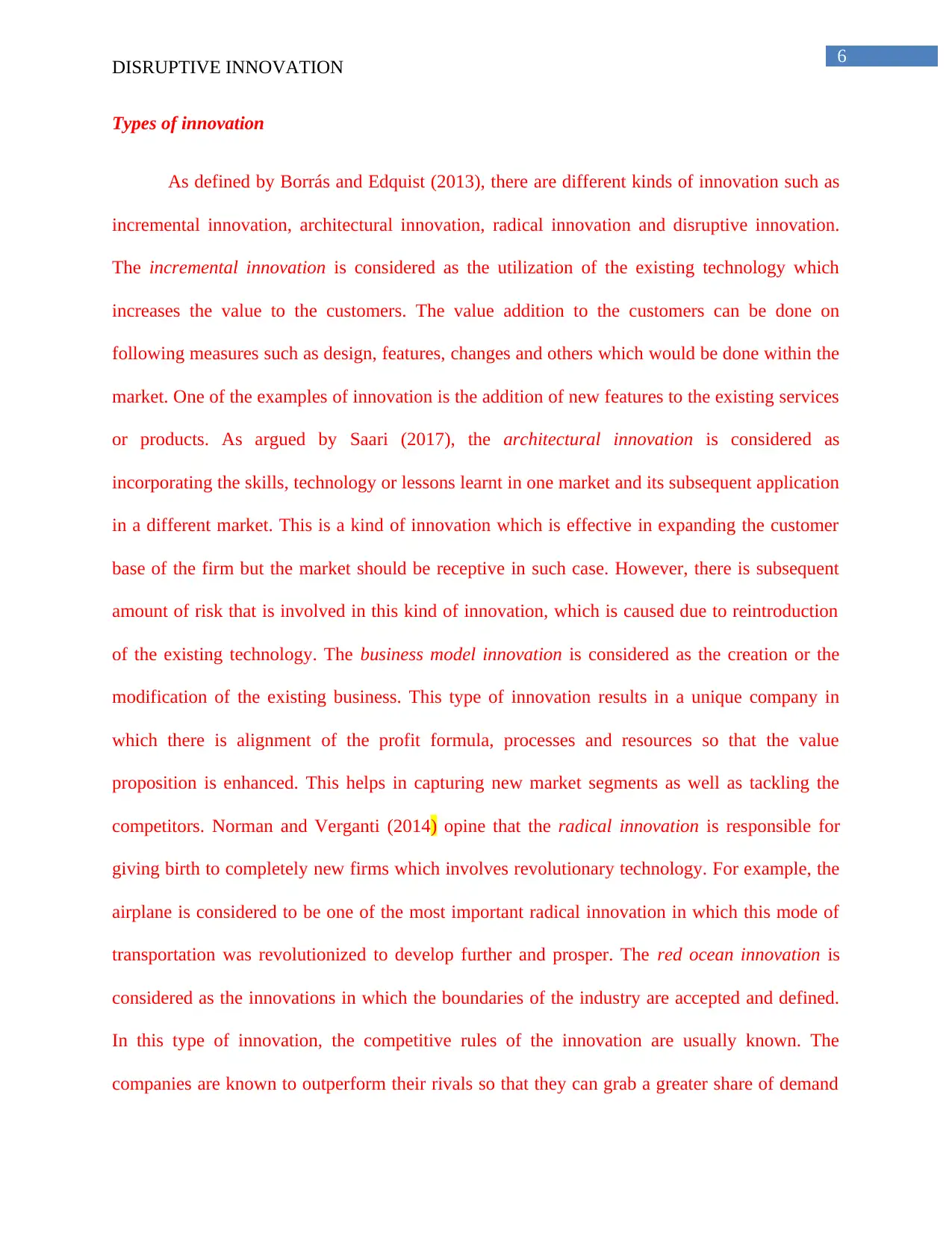
6
DISRUPTIVE INNOVATION
Types of innovation
As defined by Borrás and Edquist (2013), there are different kinds of innovation such as
incremental innovation, architectural innovation, radical innovation and disruptive innovation.
The incremental innovation is considered as the utilization of the existing technology which
increases the value to the customers. The value addition to the customers can be done on
following measures such as design, features, changes and others which would be done within the
market. One of the examples of innovation is the addition of new features to the existing services
or products. As argued by Saari (2017), the architectural innovation is considered as
incorporating the skills, technology or lessons learnt in one market and its subsequent application
in a different market. This is a kind of innovation which is effective in expanding the customer
base of the firm but the market should be receptive in such case. However, there is subsequent
amount of risk that is involved in this kind of innovation, which is caused due to reintroduction
of the existing technology. The business model innovation is considered as the creation or the
modification of the existing business. This type of innovation results in a unique company in
which there is alignment of the profit formula, processes and resources so that the value
proposition is enhanced. This helps in capturing new market segments as well as tackling the
competitors. Norman and Verganti (2014) opine that the radical innovation is responsible for
giving birth to completely new firms which involves revolutionary technology. For example, the
airplane is considered to be one of the most important radical innovation in which this mode of
transportation was revolutionized to develop further and prosper. The red ocean innovation is
considered as the innovations in which the boundaries of the industry are accepted and defined.
In this type of innovation, the competitive rules of the innovation are usually known. The
companies are known to outperform their rivals so that they can grab a greater share of demand
DISRUPTIVE INNOVATION
Types of innovation
As defined by Borrás and Edquist (2013), there are different kinds of innovation such as
incremental innovation, architectural innovation, radical innovation and disruptive innovation.
The incremental innovation is considered as the utilization of the existing technology which
increases the value to the customers. The value addition to the customers can be done on
following measures such as design, features, changes and others which would be done within the
market. One of the examples of innovation is the addition of new features to the existing services
or products. As argued by Saari (2017), the architectural innovation is considered as
incorporating the skills, technology or lessons learnt in one market and its subsequent application
in a different market. This is a kind of innovation which is effective in expanding the customer
base of the firm but the market should be receptive in such case. However, there is subsequent
amount of risk that is involved in this kind of innovation, which is caused due to reintroduction
of the existing technology. The business model innovation is considered as the creation or the
modification of the existing business. This type of innovation results in a unique company in
which there is alignment of the profit formula, processes and resources so that the value
proposition is enhanced. This helps in capturing new market segments as well as tackling the
competitors. Norman and Verganti (2014) opine that the radical innovation is responsible for
giving birth to completely new firms which involves revolutionary technology. For example, the
airplane is considered to be one of the most important radical innovation in which this mode of
transportation was revolutionized to develop further and prosper. The red ocean innovation is
considered as the innovations in which the boundaries of the industry are accepted and defined.
In this type of innovation, the competitive rules of the innovation are usually known. The
companies are known to outperform their rivals so that they can grab a greater share of demand
Paraphrase This Document
Need a fresh take? Get an instant paraphrase of this document with our AI Paraphraser
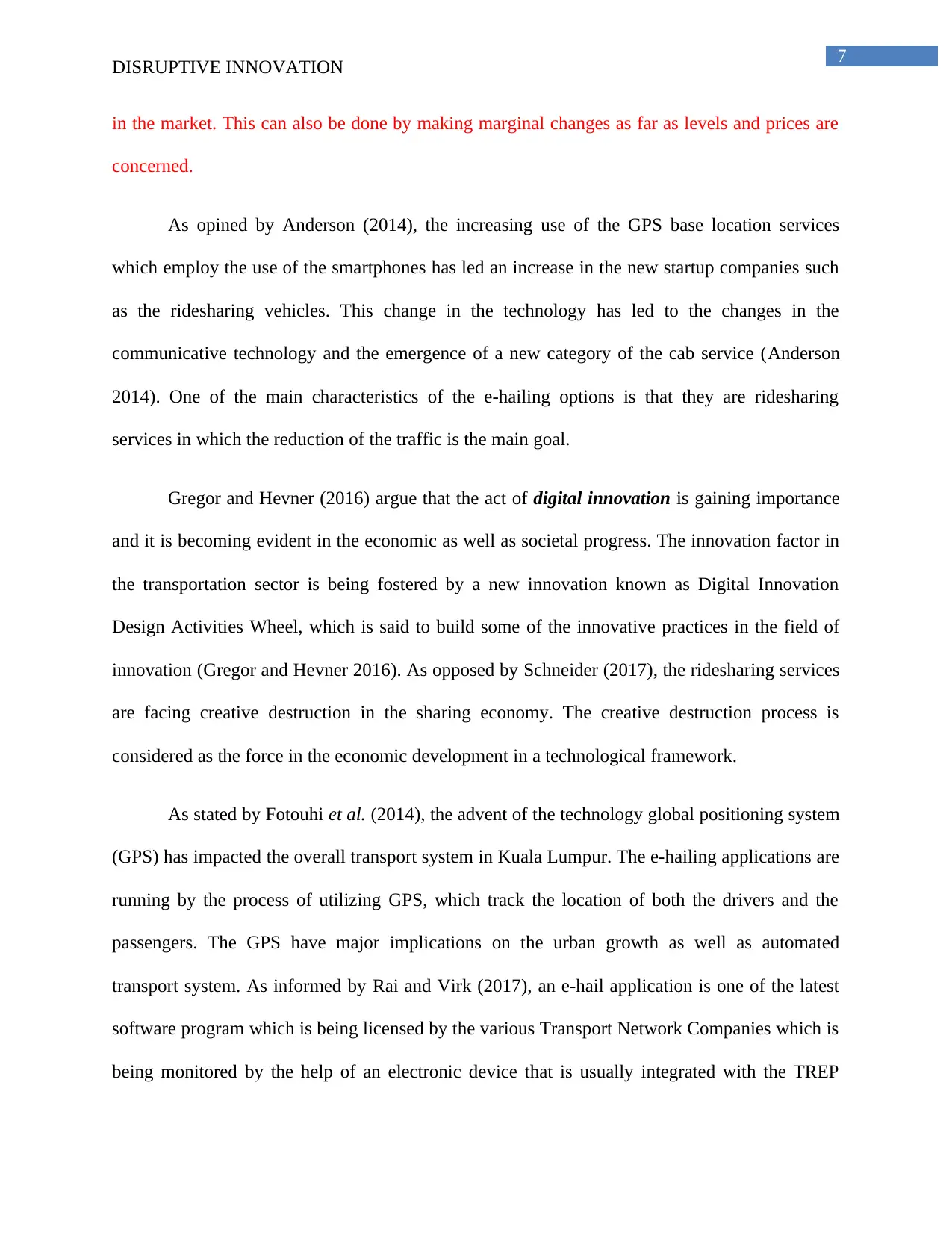
7
DISRUPTIVE INNOVATION
in the market. This can also be done by making marginal changes as far as levels and prices are
concerned.
As opined by Anderson (2014), the increasing use of the GPS base location services
which employ the use of the smartphones has led an increase in the new startup companies such
as the ridesharing vehicles. This change in the technology has led to the changes in the
communicative technology and the emergence of a new category of the cab service (Anderson
2014). One of the main characteristics of the e-hailing options is that they are ridesharing
services in which the reduction of the traffic is the main goal.
Gregor and Hevner (2016) argue that the act of digital innovation is gaining importance
and it is becoming evident in the economic as well as societal progress. The innovation factor in
the transportation sector is being fostered by a new innovation known as Digital Innovation
Design Activities Wheel, which is said to build some of the innovative practices in the field of
innovation (Gregor and Hevner 2016). As opposed by Schneider (2017), the ridesharing services
are facing creative destruction in the sharing economy. The creative destruction process is
considered as the force in the economic development in a technological framework.
As stated by Fotouhi et al. (2014), the advent of the technology global positioning system
(GPS) has impacted the overall transport system in Kuala Lumpur. The e-hailing applications are
running by the process of utilizing GPS, which track the location of both the drivers and the
passengers. The GPS have major implications on the urban growth as well as automated
transport system. As informed by Rai and Virk (2017), an e-hail application is one of the latest
software program which is being licensed by the various Transport Network Companies which is
being monitored by the help of an electronic device that is usually integrated with the TREP
DISRUPTIVE INNOVATION
in the market. This can also be done by making marginal changes as far as levels and prices are
concerned.
As opined by Anderson (2014), the increasing use of the GPS base location services
which employ the use of the smartphones has led an increase in the new startup companies such
as the ridesharing vehicles. This change in the technology has led to the changes in the
communicative technology and the emergence of a new category of the cab service (Anderson
2014). One of the main characteristics of the e-hailing options is that they are ridesharing
services in which the reduction of the traffic is the main goal.
Gregor and Hevner (2016) argue that the act of digital innovation is gaining importance
and it is becoming evident in the economic as well as societal progress. The innovation factor in
the transportation sector is being fostered by a new innovation known as Digital Innovation
Design Activities Wheel, which is said to build some of the innovative practices in the field of
innovation (Gregor and Hevner 2016). As opposed by Schneider (2017), the ridesharing services
are facing creative destruction in the sharing economy. The creative destruction process is
considered as the force in the economic development in a technological framework.
As stated by Fotouhi et al. (2014), the advent of the technology global positioning system
(GPS) has impacted the overall transport system in Kuala Lumpur. The e-hailing applications are
running by the process of utilizing GPS, which track the location of both the drivers and the
passengers. The GPS have major implications on the urban growth as well as automated
transport system. As informed by Rai and Virk (2017), an e-hail application is one of the latest
software program which is being licensed by the various Transport Network Companies which is
being monitored by the help of an electronic device that is usually integrated with the TREP
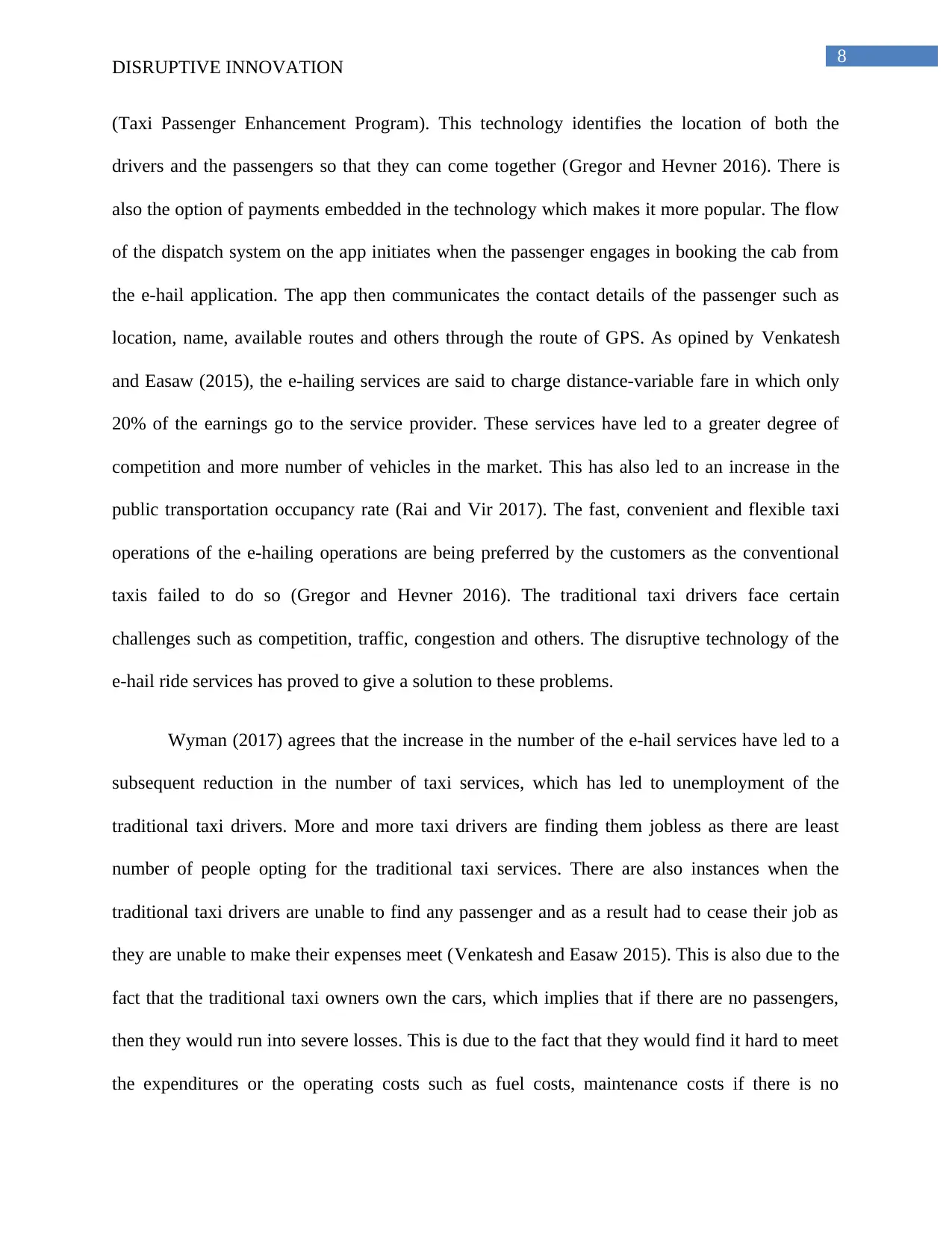
8
DISRUPTIVE INNOVATION
(Taxi Passenger Enhancement Program). This technology identifies the location of both the
drivers and the passengers so that they can come together (Gregor and Hevner 2016). There is
also the option of payments embedded in the technology which makes it more popular. The flow
of the dispatch system on the app initiates when the passenger engages in booking the cab from
the e-hail application. The app then communicates the contact details of the passenger such as
location, name, available routes and others through the route of GPS. As opined by Venkatesh
and Easaw (2015), the e-hailing services are said to charge distance-variable fare in which only
20% of the earnings go to the service provider. These services have led to a greater degree of
competition and more number of vehicles in the market. This has also led to an increase in the
public transportation occupancy rate (Rai and Vir 2017). The fast, convenient and flexible taxi
operations of the e-hailing operations are being preferred by the customers as the conventional
taxis failed to do so (Gregor and Hevner 2016). The traditional taxi drivers face certain
challenges such as competition, traffic, congestion and others. The disruptive technology of the
e-hail ride services has proved to give a solution to these problems.
Wyman (2017) agrees that the increase in the number of the e-hail services have led to a
subsequent reduction in the number of taxi services, which has led to unemployment of the
traditional taxi drivers. More and more taxi drivers are finding them jobless as there are least
number of people opting for the traditional taxi services. There are also instances when the
traditional taxi drivers are unable to find any passenger and as a result had to cease their job as
they are unable to make their expenses meet (Venkatesh and Easaw 2015). This is also due to the
fact that the traditional taxi owners own the cars, which implies that if there are no passengers,
then they would run into severe losses. This is due to the fact that they would find it hard to meet
the expenditures or the operating costs such as fuel costs, maintenance costs if there is no
DISRUPTIVE INNOVATION
(Taxi Passenger Enhancement Program). This technology identifies the location of both the
drivers and the passengers so that they can come together (Gregor and Hevner 2016). There is
also the option of payments embedded in the technology which makes it more popular. The flow
of the dispatch system on the app initiates when the passenger engages in booking the cab from
the e-hail application. The app then communicates the contact details of the passenger such as
location, name, available routes and others through the route of GPS. As opined by Venkatesh
and Easaw (2015), the e-hailing services are said to charge distance-variable fare in which only
20% of the earnings go to the service provider. These services have led to a greater degree of
competition and more number of vehicles in the market. This has also led to an increase in the
public transportation occupancy rate (Rai and Vir 2017). The fast, convenient and flexible taxi
operations of the e-hailing operations are being preferred by the customers as the conventional
taxis failed to do so (Gregor and Hevner 2016). The traditional taxi drivers face certain
challenges such as competition, traffic, congestion and others. The disruptive technology of the
e-hail ride services has proved to give a solution to these problems.
Wyman (2017) agrees that the increase in the number of the e-hail services have led to a
subsequent reduction in the number of taxi services, which has led to unemployment of the
traditional taxi drivers. More and more taxi drivers are finding them jobless as there are least
number of people opting for the traditional taxi services. There are also instances when the
traditional taxi drivers are unable to find any passenger and as a result had to cease their job as
they are unable to make their expenses meet (Venkatesh and Easaw 2015). This is also due to the
fact that the traditional taxi owners own the cars, which implies that if there are no passengers,
then they would run into severe losses. This is due to the fact that they would find it hard to meet
the expenditures or the operating costs such as fuel costs, maintenance costs if there is no
⊘ This is a preview!⊘
Do you want full access?
Subscribe today to unlock all pages.

Trusted by 1+ million students worldwide
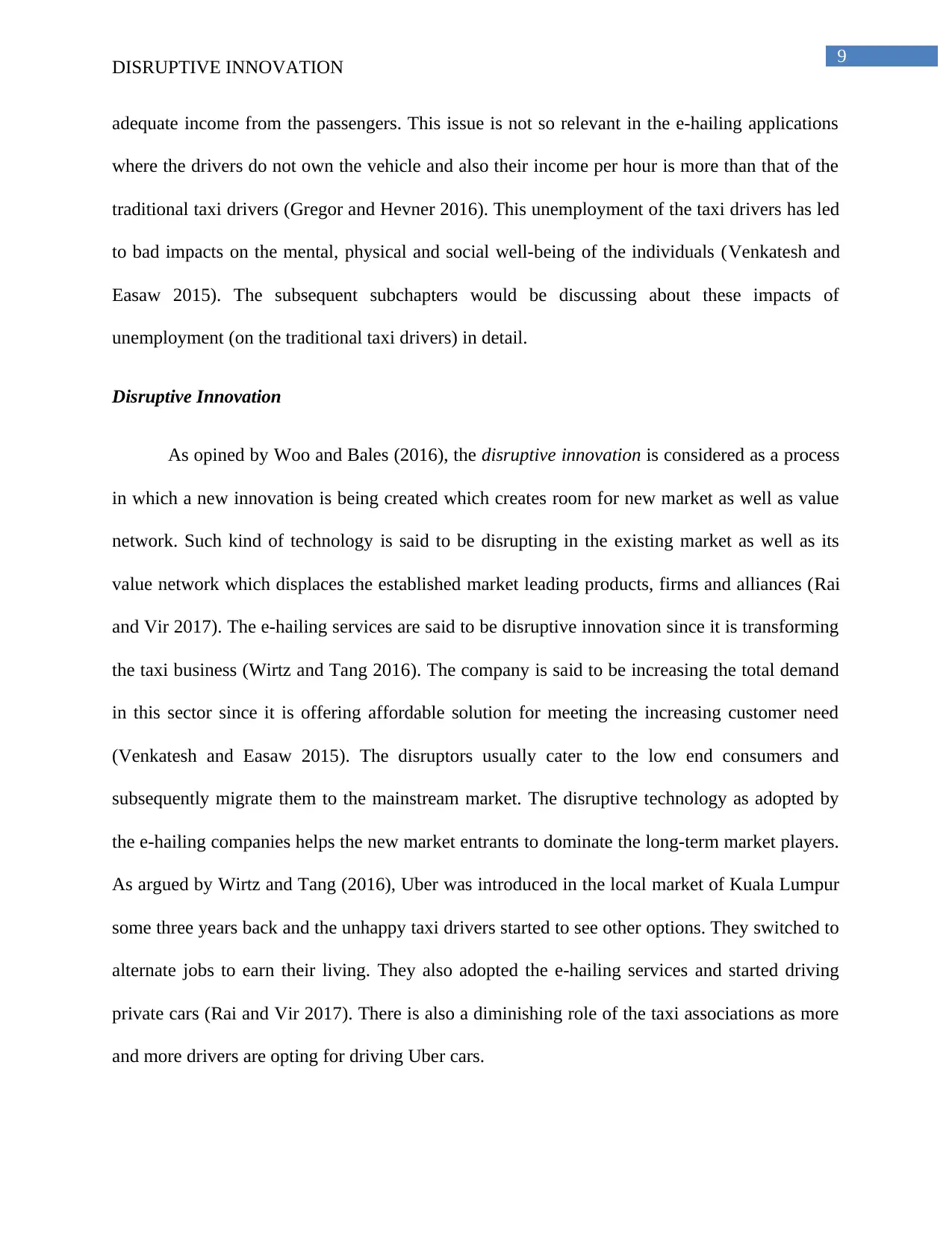
9
DISRUPTIVE INNOVATION
adequate income from the passengers. This issue is not so relevant in the e-hailing applications
where the drivers do not own the vehicle and also their income per hour is more than that of the
traditional taxi drivers (Gregor and Hevner 2016). This unemployment of the taxi drivers has led
to bad impacts on the mental, physical and social well-being of the individuals (Venkatesh and
Easaw 2015). The subsequent subchapters would be discussing about these impacts of
unemployment (on the traditional taxi drivers) in detail.
Disruptive Innovation
As opined by Woo and Bales (2016), the disruptive innovation is considered as a process
in which a new innovation is being created which creates room for new market as well as value
network. Such kind of technology is said to be disrupting in the existing market as well as its
value network which displaces the established market leading products, firms and alliances (Rai
and Vir 2017). The e-hailing services are said to be disruptive innovation since it is transforming
the taxi business (Wirtz and Tang 2016). The company is said to be increasing the total demand
in this sector since it is offering affordable solution for meeting the increasing customer need
(Venkatesh and Easaw 2015). The disruptors usually cater to the low end consumers and
subsequently migrate them to the mainstream market. The disruptive technology as adopted by
the e-hailing companies helps the new market entrants to dominate the long-term market players.
As argued by Wirtz and Tang (2016), Uber was introduced in the local market of Kuala Lumpur
some three years back and the unhappy taxi drivers started to see other options. They switched to
alternate jobs to earn their living. They also adopted the e-hailing services and started driving
private cars (Rai and Vir 2017). There is also a diminishing role of the taxi associations as more
and more drivers are opting for driving Uber cars.
DISRUPTIVE INNOVATION
adequate income from the passengers. This issue is not so relevant in the e-hailing applications
where the drivers do not own the vehicle and also their income per hour is more than that of the
traditional taxi drivers (Gregor and Hevner 2016). This unemployment of the taxi drivers has led
to bad impacts on the mental, physical and social well-being of the individuals (Venkatesh and
Easaw 2015). The subsequent subchapters would be discussing about these impacts of
unemployment (on the traditional taxi drivers) in detail.
Disruptive Innovation
As opined by Woo and Bales (2016), the disruptive innovation is considered as a process
in which a new innovation is being created which creates room for new market as well as value
network. Such kind of technology is said to be disrupting in the existing market as well as its
value network which displaces the established market leading products, firms and alliances (Rai
and Vir 2017). The e-hailing services are said to be disruptive innovation since it is transforming
the taxi business (Wirtz and Tang 2016). The company is said to be increasing the total demand
in this sector since it is offering affordable solution for meeting the increasing customer need
(Venkatesh and Easaw 2015). The disruptors usually cater to the low end consumers and
subsequently migrate them to the mainstream market. The disruptive technology as adopted by
the e-hailing companies helps the new market entrants to dominate the long-term market players.
As argued by Wirtz and Tang (2016), Uber was introduced in the local market of Kuala Lumpur
some three years back and the unhappy taxi drivers started to see other options. They switched to
alternate jobs to earn their living. They also adopted the e-hailing services and started driving
private cars (Rai and Vir 2017). There is also a diminishing role of the taxi associations as more
and more drivers are opting for driving Uber cars.
Paraphrase This Document
Need a fresh take? Get an instant paraphrase of this document with our AI Paraphraser
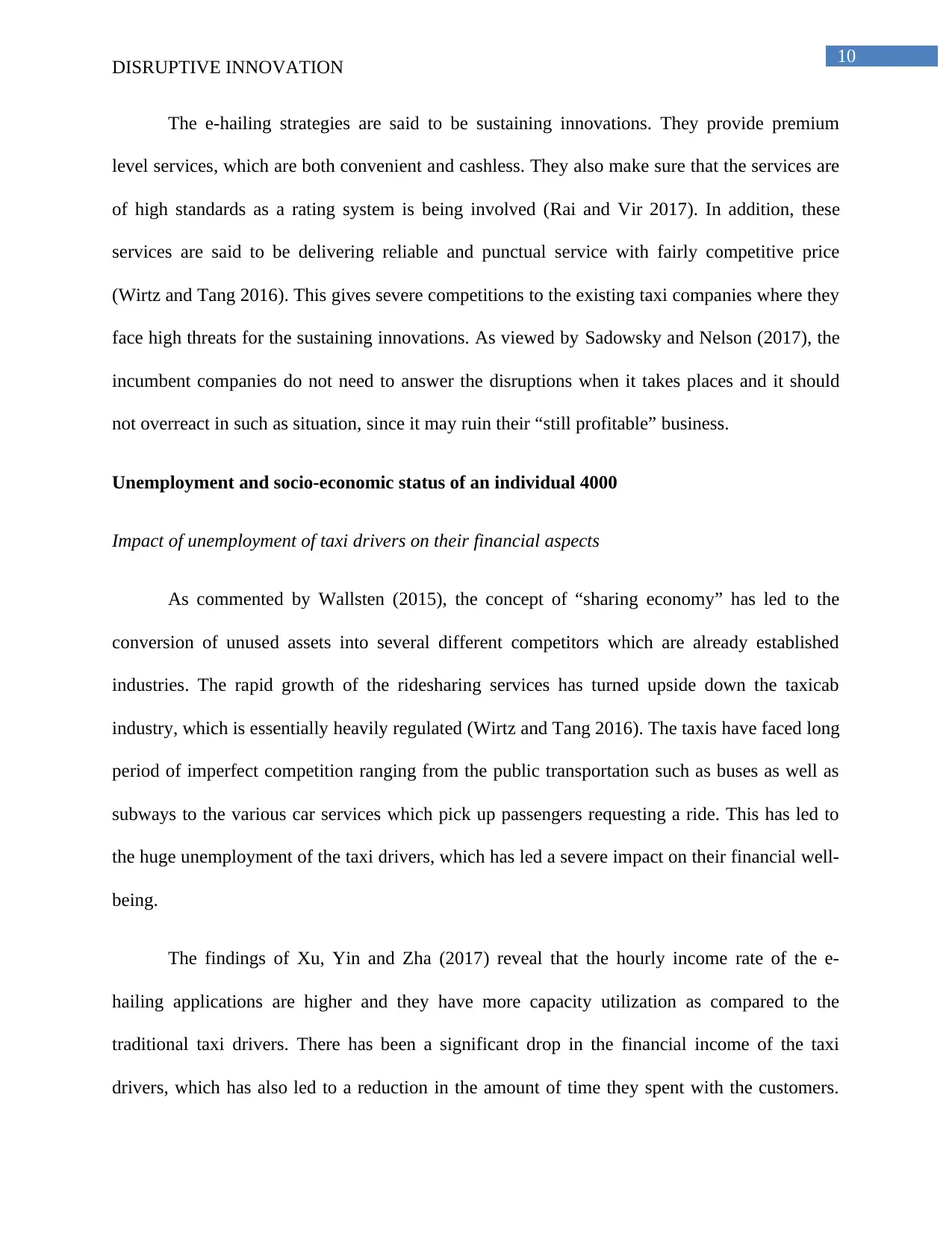
10
DISRUPTIVE INNOVATION
The e-hailing strategies are said to be sustaining innovations. They provide premium
level services, which are both convenient and cashless. They also make sure that the services are
of high standards as a rating system is being involved (Rai and Vir 2017). In addition, these
services are said to be delivering reliable and punctual service with fairly competitive price
(Wirtz and Tang 2016). This gives severe competitions to the existing taxi companies where they
face high threats for the sustaining innovations. As viewed by Sadowsky and Nelson (2017), the
incumbent companies do not need to answer the disruptions when it takes places and it should
not overreact in such as situation, since it may ruin their “still profitable” business.
Unemployment and socio-economic status of an individual 4000
Impact of unemployment of taxi drivers on their financial aspects
As commented by Wallsten (2015), the concept of “sharing economy” has led to the
conversion of unused assets into several different competitors which are already established
industries. The rapid growth of the ridesharing services has turned upside down the taxicab
industry, which is essentially heavily regulated (Wirtz and Tang 2016). The taxis have faced long
period of imperfect competition ranging from the public transportation such as buses as well as
subways to the various car services which pick up passengers requesting a ride. This has led to
the huge unemployment of the taxi drivers, which has led a severe impact on their financial well-
being.
The findings of Xu, Yin and Zha (2017) reveal that the hourly income rate of the e-
hailing applications are higher and they have more capacity utilization as compared to the
traditional taxi drivers. There has been a significant drop in the financial income of the taxi
drivers, which has also led to a reduction in the amount of time they spent with the customers.
DISRUPTIVE INNOVATION
The e-hailing strategies are said to be sustaining innovations. They provide premium
level services, which are both convenient and cashless. They also make sure that the services are
of high standards as a rating system is being involved (Rai and Vir 2017). In addition, these
services are said to be delivering reliable and punctual service with fairly competitive price
(Wirtz and Tang 2016). This gives severe competitions to the existing taxi companies where they
face high threats for the sustaining innovations. As viewed by Sadowsky and Nelson (2017), the
incumbent companies do not need to answer the disruptions when it takes places and it should
not overreact in such as situation, since it may ruin their “still profitable” business.
Unemployment and socio-economic status of an individual 4000
Impact of unemployment of taxi drivers on their financial aspects
As commented by Wallsten (2015), the concept of “sharing economy” has led to the
conversion of unused assets into several different competitors which are already established
industries. The rapid growth of the ridesharing services has turned upside down the taxicab
industry, which is essentially heavily regulated (Wirtz and Tang 2016). The taxis have faced long
period of imperfect competition ranging from the public transportation such as buses as well as
subways to the various car services which pick up passengers requesting a ride. This has led to
the huge unemployment of the taxi drivers, which has led a severe impact on their financial well-
being.
The findings of Xu, Yin and Zha (2017) reveal that the hourly income rate of the e-
hailing applications are higher and they have more capacity utilization as compared to the
traditional taxi drivers. There has been a significant drop in the financial income of the taxi
drivers, which has also led to a reduction in the amount of time they spent with the customers.
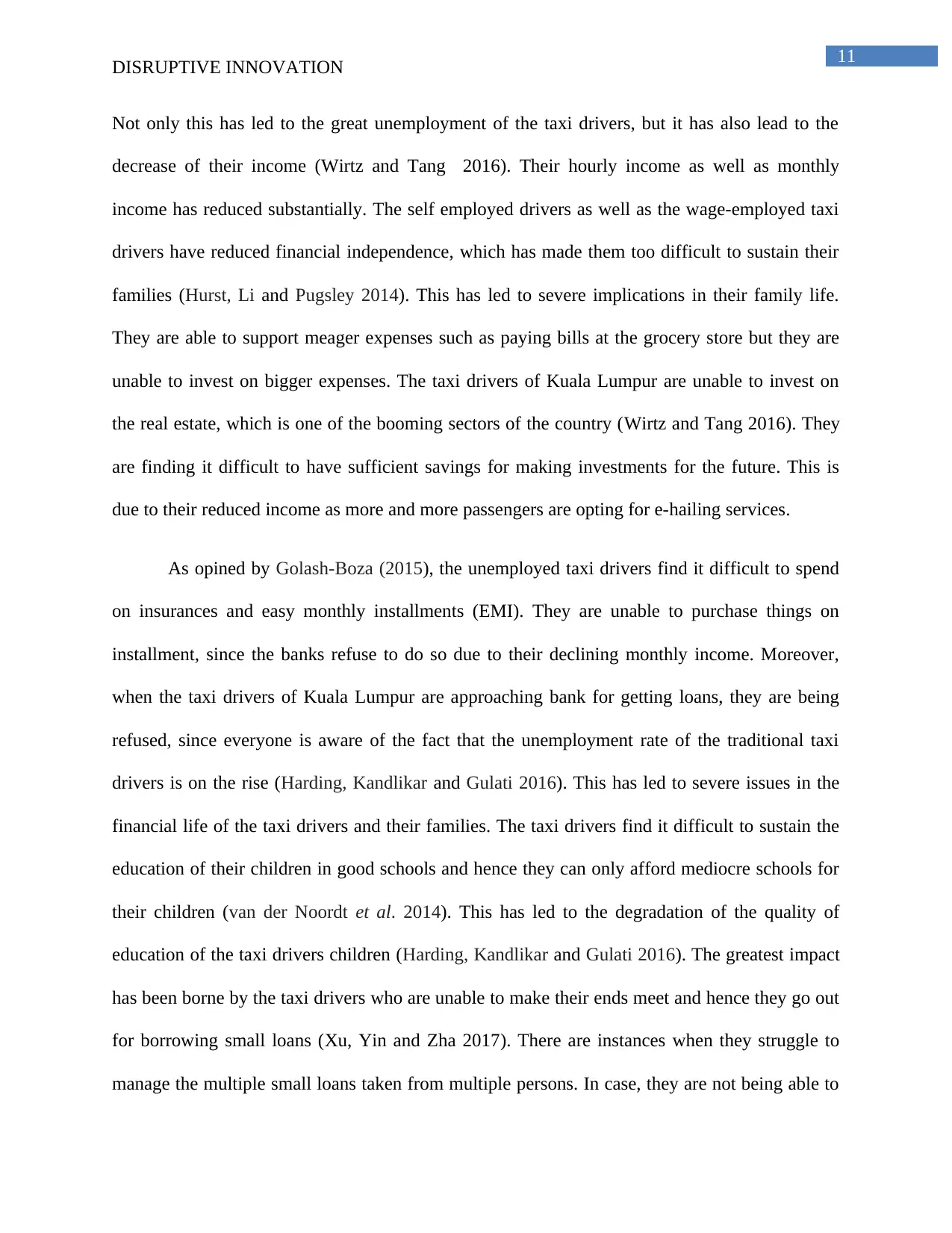
11
DISRUPTIVE INNOVATION
Not only this has led to the great unemployment of the taxi drivers, but it has also lead to the
decrease of their income (Wirtz and Tang 2016). Their hourly income as well as monthly
income has reduced substantially. The self employed drivers as well as the wage-employed taxi
drivers have reduced financial independence, which has made them too difficult to sustain their
families (Hurst, Li and Pugsley 2014). This has led to severe implications in their family life.
They are able to support meager expenses such as paying bills at the grocery store but they are
unable to invest on bigger expenses. The taxi drivers of Kuala Lumpur are unable to invest on
the real estate, which is one of the booming sectors of the country (Wirtz and Tang 2016). They
are finding it difficult to have sufficient savings for making investments for the future. This is
due to their reduced income as more and more passengers are opting for e-hailing services.
As opined by Golash-Boza (2015), the unemployed taxi drivers find it difficult to spend
on insurances and easy monthly installments (EMI). They are unable to purchase things on
installment, since the banks refuse to do so due to their declining monthly income. Moreover,
when the taxi drivers of Kuala Lumpur are approaching bank for getting loans, they are being
refused, since everyone is aware of the fact that the unemployment rate of the traditional taxi
drivers is on the rise (Harding, Kandlikar and Gulati 2016). This has led to severe issues in the
financial life of the taxi drivers and their families. The taxi drivers find it difficult to sustain the
education of their children in good schools and hence they can only afford mediocre schools for
their children (van der Noordt et al. 2014). This has led to the degradation of the quality of
education of the taxi drivers children (Harding, Kandlikar and Gulati 2016). The greatest impact
has been borne by the taxi drivers who are unable to make their ends meet and hence they go out
for borrowing small loans (Xu, Yin and Zha 2017). There are instances when they struggle to
manage the multiple small loans taken from multiple persons. In case, they are not being able to
DISRUPTIVE INNOVATION
Not only this has led to the great unemployment of the taxi drivers, but it has also lead to the
decrease of their income (Wirtz and Tang 2016). Their hourly income as well as monthly
income has reduced substantially. The self employed drivers as well as the wage-employed taxi
drivers have reduced financial independence, which has made them too difficult to sustain their
families (Hurst, Li and Pugsley 2014). This has led to severe implications in their family life.
They are able to support meager expenses such as paying bills at the grocery store but they are
unable to invest on bigger expenses. The taxi drivers of Kuala Lumpur are unable to invest on
the real estate, which is one of the booming sectors of the country (Wirtz and Tang 2016). They
are finding it difficult to have sufficient savings for making investments for the future. This is
due to their reduced income as more and more passengers are opting for e-hailing services.
As opined by Golash-Boza (2015), the unemployed taxi drivers find it difficult to spend
on insurances and easy monthly installments (EMI). They are unable to purchase things on
installment, since the banks refuse to do so due to their declining monthly income. Moreover,
when the taxi drivers of Kuala Lumpur are approaching bank for getting loans, they are being
refused, since everyone is aware of the fact that the unemployment rate of the traditional taxi
drivers is on the rise (Harding, Kandlikar and Gulati 2016). This has led to severe issues in the
financial life of the taxi drivers and their families. The taxi drivers find it difficult to sustain the
education of their children in good schools and hence they can only afford mediocre schools for
their children (van der Noordt et al. 2014). This has led to the degradation of the quality of
education of the taxi drivers children (Harding, Kandlikar and Gulati 2016). The greatest impact
has been borne by the taxi drivers who are unable to make their ends meet and hence they go out
for borrowing small loans (Xu, Yin and Zha 2017). There are instances when they struggle to
manage the multiple small loans taken from multiple persons. In case, they are not being able to
⊘ This is a preview!⊘
Do you want full access?
Subscribe today to unlock all pages.

Trusted by 1+ million students worldwide
1 out of 28
Related Documents
Your All-in-One AI-Powered Toolkit for Academic Success.
+13062052269
info@desklib.com
Available 24*7 on WhatsApp / Email
![[object Object]](/_next/static/media/star-bottom.7253800d.svg)
Unlock your academic potential
Copyright © 2020–2025 A2Z Services. All Rights Reserved. Developed and managed by ZUCOL.





